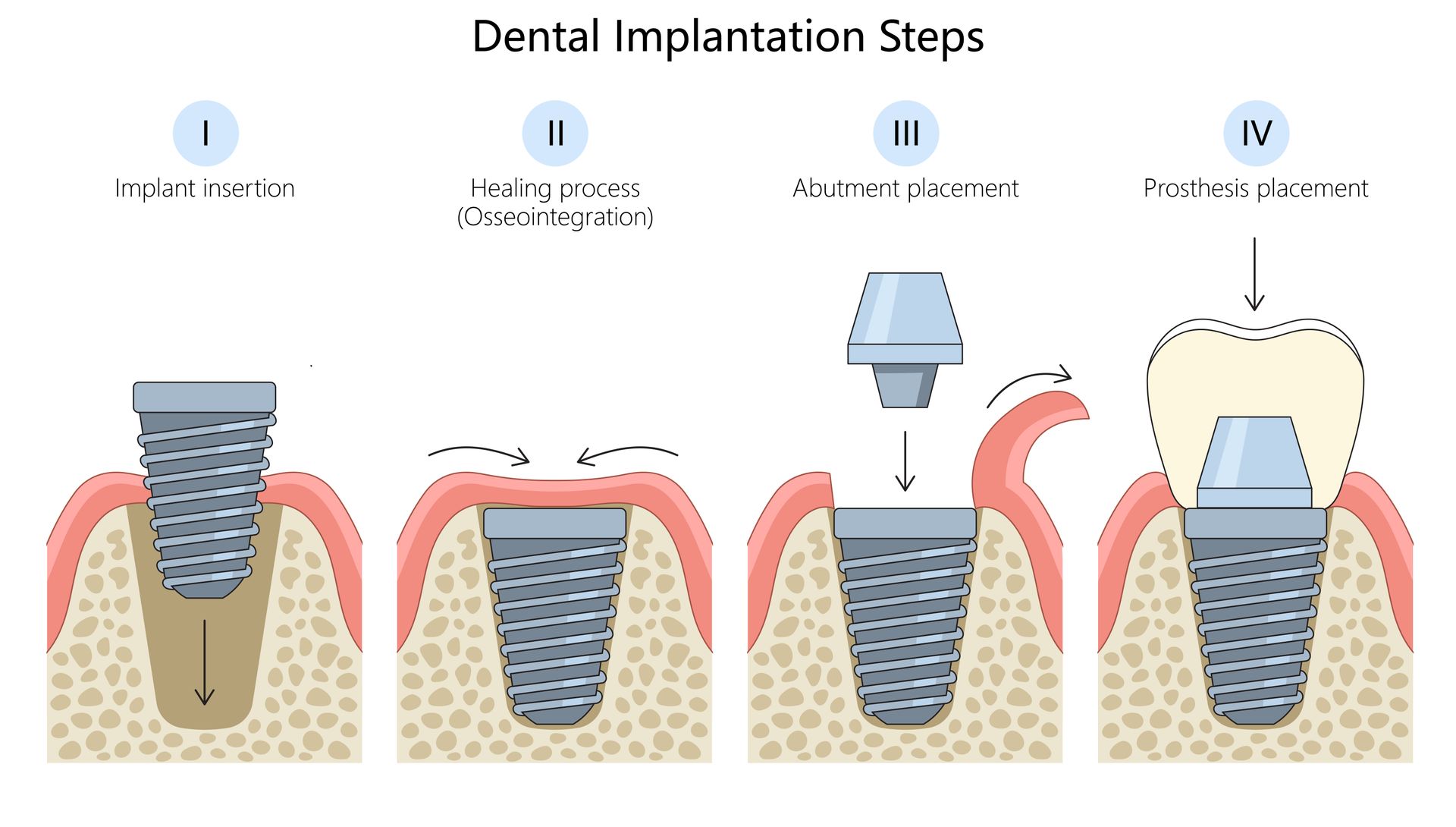Implant in Dentistry: Everything You Need to Know About Surgery & Benefits
A dental implant in dentistry is a titanium post placed in the jawbone to act as a tooth root for a missing tooth. This dependable solution offers the look and function of natural teeth. In this guide, we’ll cover what a dental implant in dentistry is, the procedure, its benefits, and who qualifies for it.
Key Takeaways
- Dental implants provide a stable foundation for prosthetic teeth, preventing jawbone loss and maintaining facial aesthetics.
- Candidates for dental implants must have good oral health and adequate jawbone density, with thorough evaluations necessary before surgery.
- Proper maintenance and hygiene practices are crucial post-surgery to ensure the longevity and success of dental implants.
Understanding Dental Implants

Dental implants are a marvel of modern implant dentistry, designed to mimic the function and appearance of natural teeth. These implants consist of metal posts, often made of titanium, which are surgically inserted into the jawbone to act as artificial tooth roots. Once in place, they provide a sturdy foundation for prosthetic teeth, whether it’s a single crown, a bridge, or even a full set of dentures.
One of the most significant advantages of dental implants is their ability to prevent jawbone loss, a common issue after tooth loss. Unlike conventional dentures that rest on the gums, implants integrate with the jawbone, stimulating and preserving bone structure. This integration not only helps maintain facial aesthetics but also ensures the long-term stability of the implants.
Dental implants offer flexibility in restoration options, supporting both fixed and removable artificial teeth. This versatility allows dental professionals to tailor treatments to individual needs, providing strength and stability that enable patients to eat, speak, and smile with confidence, including options for full mouth dental implants.
Who Qualifies for Dental Implants?
Not everyone is an ideal candidate for dental implants, but many individuals can benefit from this transformative procedure. Good oral health and adequate jawbone density are crucial prerequisites. A thorough examination of the teeth and gums, along with imaging to assess bone density, is conducted during the initial consultation to ensure suitability for the procedure.
Certain health conditions, such as uncontrolled diabetes or autoimmune disorders, may require additional evaluation before proceeding with dental implants. Chronic diseases like cancer need to be managed appropriately to ensure the best possible outcome. Furthermore, it’s essential to address any existing oral health issues, such as tooth decay or gum disease, before undergoing implant surgery.
Patients must also demonstrate a commitment to maintaining excellent oral hygiene post-surgery. Regular dental check-ups are vital to monitor the health of the implants and surrounding tissues, ensuring long-term success. For those with insufficient jawbone density, subperiosteal implants might be an option, avoiding the need for bone grafting.
The Dental Implant Procedure

The dental implant procedure is a multi-step process that involves careful planning and precise execution, including dental implant procedures. It begins with an initial consultation and planning phase, followed by the surgical procedure of dental implant placement, a period of osseointegration and bone growth, and finally, the attachment of the abutment and the new artificial tooth. Dental implant treatment is essential for ensuring the success of this process.
Each step is critical to ensuring the long-term success and functionality of the dental implants.
Initial Consultation and Planning

The journey to getting dental implants starts with a comprehensive initial consultation. During this visit, the dentist evaluates the patient’s overall oral health, takes necessary imaging, and discusses the treatment plan. This plan is personalized to the patient’s specific needs and conditions, ensuring the best possible outcome.
Options for anesthesia and sedation are also discussed to ensure patient comfort throughout the procedure. This thorough planning phase is crucial as it sets the stage for the entire dental implant process, making sure that the patient is well-informed and prepared for the upcoming surgery.
Placing the Implant Post
The next phase involves the surgical placement of the dental implant post. Under local anesthesia, the surgeon makes an incision in the gum to expose the jawbone. A hole is then drilled into the bone, and the metal implant post is inserted deep into it. This post acts as an artificial tooth root, providing a stable base for the future prosthetic tooth. Additionally, it is important to know how to place dental implants effectively.
In cases where the jawbone is not thick enough or too soft, a bone graft may be required to provide a solid foundation for the implant. Proper positioning of the implant is crucial to avoid vital structures and ensure successful integration with the bone.
Osseointegration and Bone Growth
Osseointegration is the process where the jawbone grows around the dental implant, securing it firmly in place. This phase is critical for the stability and longevity of the implant, as it ensures that the implant can function like a natural tooth root.
This process can take several months, during which the bone heals and integrates with the implant. Only once the jawbone is strong enough and osseointegration is successful can the next step of the procedure be undertaken.
Attaching the Abutment
Once osseointegration is complete, the next step is to attach the abutment. This small connector piece is placed on top of the implant post and serves as a base for the new artificial tooth. The gum tissue around the abutment needs time to heal properly, which typically takes several weeks.
The abutment ensures that the replacement tooth is securely attached and can withstand the forces of chewing and biting. This step is crucial for the overall success of the dental implant procedure.
Choosing and Placing the New Artificial Tooth
The final step in the dental implant process is selecting and placing the new artificial tooth. Impressions of the mouth and remaining teeth are taken to create a custom crown that fits perfectly. This crown is then attached to the abutment, completing the restoration and providing a natural-looking and functional replacement tooth.
This process ensures that the new tooth matches the patient’s natural teeth in shape, size, and color, providing a seamless and aesthetically pleasing result.
Recovery and Aftercare
The recovery period after dental implant surgery is a critical phase that requires careful attention and adherence to post-operative care instructions. Factors such as the complexity of the procedure, the patient’s oral hygiene, and lifestyle habits like smoking can influence the healing process.
Immediately after minor surgery, it’s essential to limit strenuous activities and apply ice packs to reduce swelling. Soft foods should be consumed for the first few days to avoid disturbing the surgical site. Over-the-counter pain relievers can help manage any discomfort during this period.
Ongoing care involves regular dental check-ups to monitor the health of the implants and surrounding tissues. Smoking should be avoided to promote healing, and gentle cleaning of the surgical area is crucial to prevent infections.
Potential Risks and Complications
While dental implant surgery is generally safe, it does carry potential risks and complications that patients should be aware of before proceeding. Infections can occur at the implant site, necessitating careful post-operative care and monitoring for signs of swelling or discharge.
Another risk involves nerve damage, which can lead to long-lasting effects if not managed properly. Sinus damage is also a potential complication for implants placed in the upper jaw, which can cause discomfort or result in infection.
If the bone fails to fuse with the implant, the implant may need to be removed and the procedure attempted again after appropriate healing.
Benefits of Dental Implants
The benefits of dental implants extend far beyond merely replacing missing teeth. One of the most significant advantages is the improved ability to chew food effectively, leading to better nutrition and overall health. Compared to dentures, implants provide superior stability and chewing power, allowing patients to enjoy a wide range of foods without discomfort.
Dental implants also help maintain jawbone integrity by preventing bone loss that typically occurs after tooth loss. They stimulate jawbone health, preserving facial structure and preventing sagging that can result from missing teeth. Additionally, implants offer a natural appearance, closely resembling natural teeth and boosting the patient’s confidence and self-esteem.
Many patients report significant improvements in their quality of life, feeling more comfortable and confident in social interactions. The emotional impact of dental implants can be profound, freeing individuals from the embarrassment of damaged or missing teeth and allowing them to smile and engage with others more freely.
Different Types of Dental Implants
There are primarily two types of dental implants: endosteal and subperiosteal. Endosteal implants are the most dental implants commonly used type, involving a titanium screw placed directly into the jawbone, resembling natural teeth. These implants are highly stable and provide a strong foundation for prosthetic teeth.
Subperiosteal implants, on the other hand, are placed on top of the jawbone and are typically used for patients with insufficient bone height. These implants consist of a metal framework with posts that extend through the gum, offering an alternative for those who may not be suitable candidates for endosteal implants.
Both types of implants have their advantages and are chosen based on the patient’s specific needs and anatomical considerations. A dental professional will recommend the best option during the initial consultation and planning phase.
Cost and Insurance Considerations
The cost of dental implants can vary widely based on several factors, including the complexity of the case, the type of implant used, and the location of the dental practice. On average, the price of a single dental implant ranges between $2,800 and $5,600.
Many dental insurance plans may cover a portion of the dental implant costs, but coverage can vary significantly across different policies. It’s essential to obtain pre-treatment estimates from your dentist to understand how much of the expenses your insurance will cover and what out-of-pocket costs to expect.
Maintaining Your Dental Implants
Maintaining dental implants requires a commitment to good oral hygiene and regular dental visits. Using a soft-bristle toothbrush and low-abrasive toothpaste can help keep the implants clean without causing damage. Daily flossing, especially around the abutments, is crucial for preventing plaque buildup and maintaining oral health.
Regular dental check-ups allow for professional cleaning and early detection of any potential issues with the implants. Smoking cessation is also important for the long-term success of dental implants, as smoking can interfere with the healing process and increase the risk of implant failure.
Comparing Dental Implants to Other Tooth Replacement Options
Dental implants offer several advantages over other tooth replacement options like dentures and bridges. Unlike dental bridges, which may last around a decade, dental implants can be permanent and last a lifetime with proper care. Implants provide the most natural feel and function, do not harm surrounding teeth, and do not require replacement like dentures or bridges.
Implants help maintain the position of nearby teeth, preventing misalignment due to gaps left by missing teeth. They also help avert gum disease by eliminating spaces that can trap food and bacteria.
Dentures, while flexible and practical for multiple missing teeth, can lead to mouth sores and bone loss over time, whereas implants integrate with the jawbone for stability. For multiple missing teeth, dentures may be the most practical option, while a dental bridge is suitable for filling gaps of three to four consecutive missing tooth.
Ultimately, the choice between dental implants, dentures, and bridges depends on the patient’s specific needs and preferences, as well as the professional recommendation of their dental provider.
Summary
Dental implants are a revolutionary solution for replacing missing teeth, offering numerous benefits over conventional dentures and bridges. From improved chewing ability and enhanced appearance to long-term oral health benefits, dental implants can significantly improve the quality of life for many patients. By understanding the dental implant procedure, potential risks, and maintenance requirements, patients can make informed decisions and enjoy the confidence of a beautiful smile.




